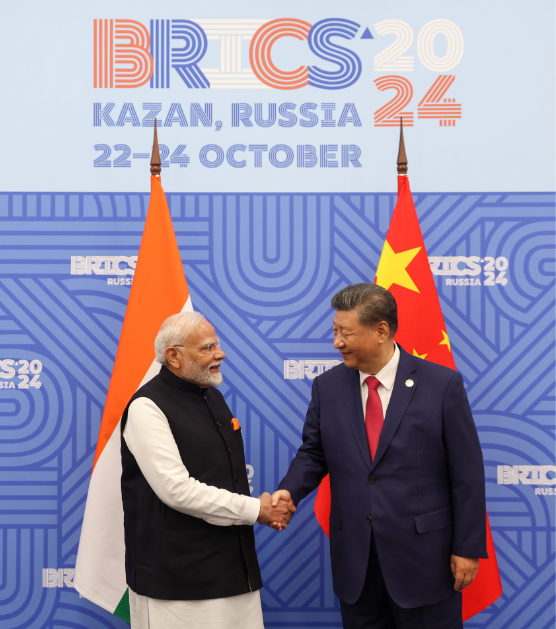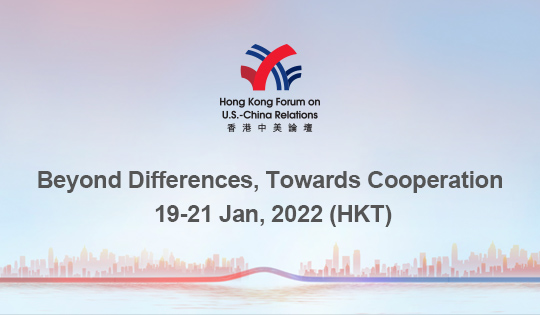
Chinese President Xi Jinping and Indian Prime Minister Narendra Modi recently met on the sidelines of the BRICS summit in Kazan – the first in five years. Both leaders pledged to direct their officials to undertake further steps to stabilise elements of bilateral ties. This came two days after New Delhi announced it had reached a deal with Beijing to address the ongoing tensions and clashes in the Himalayas.
A month prior to this important meeting, Indian Foreign Minister Subrahmanyam Jaishankar noted that India can “chew gum and walk at the same time”, when asked to comment on his country’s membership of both the U.S.-driven Quad and China-Russia-aligned BRICS.
This, in turn, came on the heels of a slew of high-level visits and meetings between senior Chinese and Indian bureaucrats throughout 2024, as both Beijing and Delhi sought to set a floor and rebuild the deeply frayed relationship between the two states. Some have argued that these meetings comprise the first serious mutual effort to stabilise interactions, since the major clash in Galwan Valley in June 2020 saw the two countries’ bilateral relationship descend to.
Inter-state Rivalry and Bloc-based Partnership
To understand where the bilateral relationship stands today, it’s imperative to take a look at the past couple of years of developments. From June 2020 to the summer of 2024, the Sino-Indian relationship is best characterised by a combination of the two tenses, albeit by no means contradictory, forces of inter-state economic and technological rivalry, and strategically induced infra-bloc partnership.
The former refers to comprehensive competition and partial confrontation between the two powers, on largely non-military dimensions of measurement and interaction. For one, whilst military stand-offs along the disputed Line of Actual Control have persisted throughout the period, the bulk of the antagonism played out elsewhere. As a symbolically significant retaliation for the 2020 border clash, India banned 59 Chinese applications – including TikTok – accusing such applications of endangering national safety. The four subsequent years saw the banning of over 300 Chinese apps – speaking to as much the encroachment of national security considerations into consumer platforms, as India’s desire to develop homegrown champions who could hopefully out-compete Chinese tech companies in the future.
Symmetrically, Beijing has ratcheted up rhetoric targeting or criticising the incumbent government in Delhi, with a particularly incendiary Weibo post during the pandemic met with ignominy and backlash from Indian netizens. In 2023, China and India found themselves embroiled in a tit-for-tat row, ejecting reporters from one another as a means of signaling strength and resolve – perhaps for largely domestic audiences. Delhi has benefited substantially from efforts by Western leaders, think-tanks strategists, and politicians calling for “de-risking” from China – with leading manufacturers and tech companies shifting parts of their supply chains in India. China, accordingly, views the techno-nationalist protectionism adopted by Indian Prime Minister Narendra Modi as a serious threat to Chinese interests.
Yet such antagonism does not thereby negate the fact that China and India have found themselves increasingly drawn to one another strategically within a mixture of regional blocs (such as BRICS, the Shanghai Cooperation Organisation (SCO)) and given international contours of power. The outbreak of the Russian war in Ukraine in February 2022 has pushed both India and China closer towards Russia on fronts of energy consumption – as both economies sought to take advantage of the considerably cheaper oil prices. Indeed, India surpassed China as the top oil buyer from Russia in July this year.
Furthermore, both governments are wary of the perils of an international order where the West can arbitrarily, with deliberateness and impunity, impose sanctions and hugely costly penalties on those who do not acquiesce to its geopolitical objectives. Neither Beijing nor Delhi is interested in directly opposing Washington, but both are certainly adamant and keen on maintaining and cultivating further strategic autonomy. BRICS – given the recent expansion in membership to include new members in Northern Africa and the Middle East – hence serves as a most productive conduit for the pursuit of this agenda.
“It’s the Economy, After All!”
What, then, has changed over recent months – such that the second of the two forces aforementioned has become precipitously potent, in nudging Beijing and Delhi towards not just de-escalation, but the express signaling of a positive secular trajectory in bilateral relations? I would posit that the answer lies with the economy, on both ends.
Some have described the present state of unemployment in India to be a “silent youth crisis”, with a significant number of college-educated individuals who are nevertheless poorer than farmhands, ostensibly. Two-thirds of India’s presently unemployed youth are educated – a proportion that has doubled since 2000. The economic malaise felt by those who are deprived of employment opportunities most certainly manifested through the lackluster performance of the ruling Bharatiya Janata Party (BJP) in the most recent General Elections, with the BJP losing a simple majority for the first time in over a decade. Whilst nursing his wounds, it is likely that Modi will seek to concentrate on bolstering India’s economic performance – which would benefit immensely from Chinese technologies, joint ventures between Chinese and Indian firms, as well as the potential opening-up of the country to Chinese investment in non-strategic sectors.
Symmetrically, as evidenced by the recent slew of stimulus measures rolled out by the Chinese authorities, it is clear that Beijing is bent on meeting the 5% growth target, and more generally orienting towards a more pro-economic growth direction in its policymaking. Whilst catering to domestic nationalist sentiments remains an important benchmark, a more urgent and salient concern pertains to restoring investor confidence, as well as rejuvenating the animal spirits of the private sector in the country. Such efforts, as I have repeatedly argued elsewhere, require genuine pragmatism and a willingness to minimise tensions when it comes to China’s relationship with both the U.S. and its neighbours.
The suboptimality of both economies’ present performances has driven their leaderships to prioritise domestic economic growth over staking and playing out their territorial differences. Whether such sentiments hold for the foreseeable future would depend on a basket of factors – including the incoming American president and the most imminent hits on Chinese exports, should Donald Trump win; the trajectory of the wars in Gaza and Ukraine, as well as the confidence of senior leaders in India and China concerning their own economic trajectories. It remains far too early to tell whether the change is here to stay. “The winds of change are blowing wild and free,” says Bob Dylan – but they could well blow in the opposite direction, should the impetus arise.
Concrete Suggestions on Bettering Sino-Indian Relations
Until then, however, there are two concrete suggestions that I have concerning the betterment of Sino-Indian relations. The first concerns the advancement of people-to-people exchanges and engagement through education, tourism, and commercial travel. Conversations between ordinary Chinese and Indian citizens – on topics wholly unrelated to sensitive areas of contention – would go a long way in eliminating mistrust and dethawing the largely frozen people-to-people exchanges on the ground. The number of flights between China and India need to be raised drastically, with a mutual push for easing of visa restrictions, in order to allow for this.
Should such changes prove to be politically infeasible, Hong Kong – as a SAR of China with its own immigration and exit-entry rules – should step up to the role of serving as a Track-2 and 1.5 dialogue platform for China and India. Hong Kong only requires Indian citizens to obtain a fairly accessible pre-arrival registration (PAR) in order to stay in the city for up to six months.
Furthermore, it is imperative that more high-level dialogues and meetings between a raft of functional departments and bureau – on both the Chinese and Indian sides – take place, with the primary objectives of identifying common grounds for collaboration and cross-pollination. For instance, on issues pertaining to climate change and the renewable transition, there is much that the two powers can do together. Artificial Intelligence regulation and safety, given the raft of releases and published documents by both NITI Aayog in India and the Cyberspace Administration of China, appear to be a low-hanging fruit on this front.
As large, transformative, and civilisationally rooted powers, neither China nor India is going anywhere anytime soon. Bolstering trust, facilitating communication, and identifying common ground are of paramount importance not only to the almost 3 billion people living in the two countries, but to the entire world at large.
